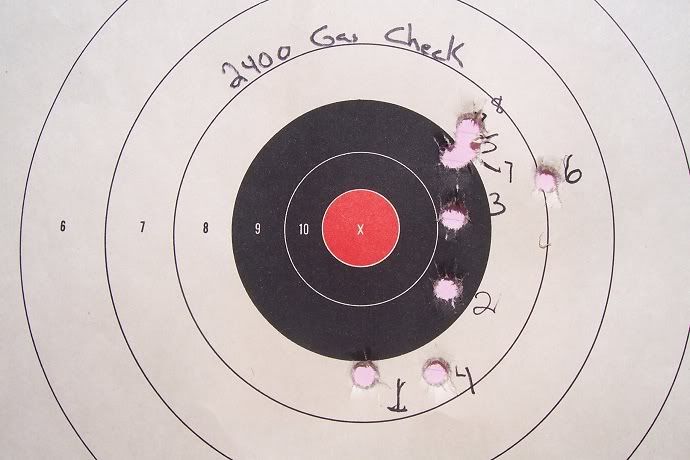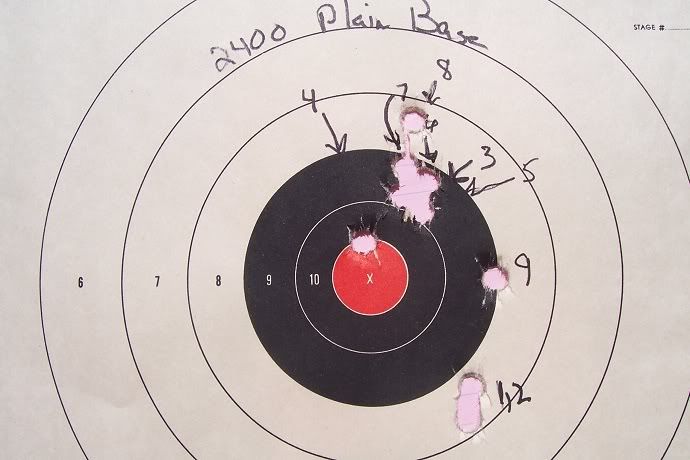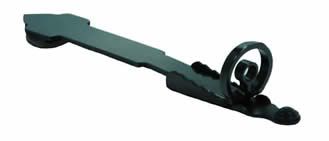The 125-RF likes to be loaded long (1.597-1.600), with the crimp below the crimp groove and right on the middle band. That makes it a great test bullet for the rifle FCD. It makes sense the collet style crimp die (this is not the pistol FCD, it's completely different), could be highly effective in the lever action. This die is available from Lee as a custom order, or from Ranch Dog who stocks them in house. The can both be found via Google. These FCD's will not work on 38 specials, the cases aren't long enough.
In the lever rifle's magazine, the firm grip prevents the bullets from being pushed further into the case. Even with max magnum loads there is no concern of a dangerous high pressure situation due to compressed case volume.
Also, in the chamber, a bullet like the 358-125-RF can be loaded enough to bump up against the rifle's throat. This is proving to be the most accurate OAL so far.
There's no reason this won't work just as well in a revolver too, but that's beyond the scope of this test. Conventional crimp groove bullets can be loaded long. But not having the groove in the way makes fitting the bullet to a gun easier, quicker and cleaner.
The rifle FCD is adjusted to touch the shell plate on the press. Adjusting it down further, the shellplate drive a inner slide up into the die, forcing the four collets to close in and crimp the case mouth. This picture shows a rifle bullet extending through the die, and the four collets crimping right on the case mouth.
The 357 bullets I'm using don't extend through the die like that, but has the four collets further down in the die body.
I wanted to show the difference in the standard roll crimp and the rifle FCD crimp. In the following picture, the first bullet is the standard roll crimp, the second pictures show a rifle FCD crimp adjusted 1/2 turn, and the third picture shows a rifle FCD crimp adjusted 3/4 turn.
It's tough to tell the differences, but it's the best shot I was able to get. I noticed that the third case has a split mouth... not good. If you click on the picture is will expand, maybe you can make out the differences.
The following pictures show test groups, at 25 yards, rested, with the iron sights on the lever rifle. It's the longest distance available, so that's what I use. To better indicate the differences, each group is 10 rounds.
These test are using the Lee 358-125-RF over 5.4 grins of Unique. An extremely accurate load, and a personal favorite.
The follow group is rifle crimp die adjuste 3/4 turn.
The best result is with the rifle crimp die adjusted 1/2 turn.
In the final analysis. When crimped directly on the bullet and not in the crimp groove, the rifle FCD is the most accurate. Adjusted 1/2 turn, for non-magnum loads. The rifle FCD may work just as well using a crimp groove, it just isn't part of this test.
Now, let's take a look at ladder test results using this bullet and Alliant 2400. In a previous post I covered the laddter test methodoloy. Basically using one loaded cartridge per powder charge, the idea is to find the two sequential charges that shoot the closest together.
To add another element of interest, there are two ladder test. One with gas checks and one with plain base bullets. I'm able to make and seat gas checks on plain base bullets such as the Lee 358-125-RF.
The numbers map to the charge, but they are different in each picture. I'll explain, first though, here is the gas check result:
The charge for each of the numbers is:
| Number | Charge |
| 7 & 8 | 16.3 |
| 6 | 15.8 |
| 5 | 15.3 |
| 4 | 14.8 |
| 3 | 14.3 |
| 2 | 13.8 |
| 1 | 13.3 |
During the test, each whole gets numbered, the target reset and then the next round is fired. Because of that 7 and 5 are misleading in the picture. In reality the potentially most accurate charge from this test is between 5 and 6, at 15.5 grains. They are closest vertically, I just pulled number 6 to the right.
Next up, the test result from the plain base bullets. Note, these are full magnum loads which produce no leading. It could be the low round count, or that gas checks aren't needed. The 16.3 grain load estimates out at 2,020 FPS. That's getting up there for a 357 magnum.
Wow, that's dramatically different. There are a wide ranges of charges that all group closely together.
This test also uses the same load for 1 & 2, a 13.3 grain charge. That's very close to previous results a few months ago, indicating 13.5 grains of 2400 to be an accurate load too.
| Number | Charge |
| 8 & 9 | 16.3 |
| 7 | 15.8 |
| 6 | 15.3 |
| 5 | 14.8 |
| 4 | 14.3 |
| 3 | 13.8 |
| 1 & 2 | 13.3 |
It turns out that the potentially most accurate load is also 15.5 grains. That load produces and estimated 1,920 FPS in a 20 inch lever rifle. Pretty sweet. The 13.5 load is fun to shoot, the 15.5 has a bit more kick to it. Not painful, but a newbee to shooting may not enjoy it as much as 13.5 or the 5.4 grains of Unique.
It's unclear so far if gas checks are needed, or helpful, for this bullet and load. The Rossi has a slow 30 inch twist that may offset the tendancy for these magnum loads to lead. If your lever action has faster twist rate, such as 16 inch, than your result may be different.
These ladder test both used the rifle FCD with a 3/4 turn crimp applied. As I continue to shake all this out and refine this die, and 2400 charges, I'll post final crimp results. Right now when using the rifle FCD, it looks like the best setting is for custom die to touch the shell plate, then add 1/2 turn for non-magnum load or 3/4 turn for magnum loads.
I'm looking forward to getting back to the range! Enjoy your time casting, loading and shooting.














